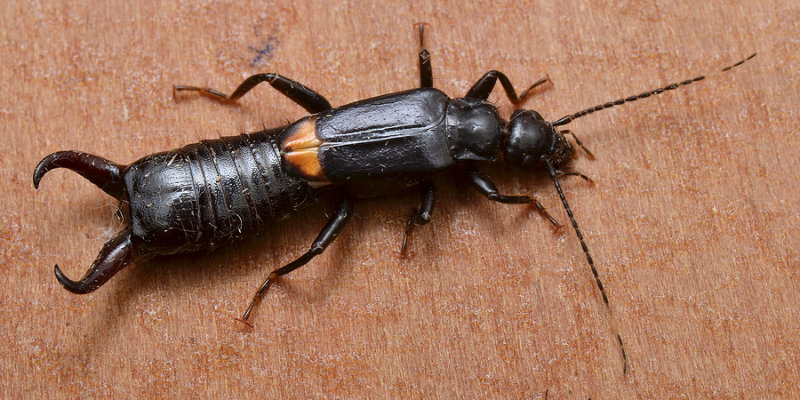Adults and nymphs have characteristic “pinchers” or forceps-like structures on the back end of their brown to black somewhat flattened bodies. They may be as long as 1 inch and have three pairs of well-developed legs. Nymphal stages are wingless, but some adult earwigs have hind wings neatly folded underneath short cover-like forewings. However, they rarely fly.

- About 10 species occur in Texas, but only a few are common. The ringlegged earwig, Euborellia annulipes (Lucas) (Labiduridae) has yellow legs with dark bands or rings on the segments. Other common species include the riparian earwig, Labidura riparia (Pallas); the linear earwig, Doru lineare (Eschscholtz); and the brown-winged earwig, Vostox brunneipennis (Serville). Earwigs are occasionally confused with rove beetles (Coleoptera: Staphylinidae), which are often elongate and have an exposed abdomen and short forewings (elytra). However, these beetles have no forceps-like structure on the end of the abdomen. Many sap beetles (Coleoptera: Nitidultidae) have short elytra as well.
- Simple metamorphosis. All developmental stages are able to overwinter. Eggs are produced in clusters and hatch in about 2 weeks. Female earwigs stay with the eggs and young nymphs. Nymphs leave the nest is a few days and thereafter develop through five stages (instars) over about 45 to 176 days, depending on temperature. Adult males have larger, more curved forceps than do females. One to two generations are produced annually.
- Earwigs are active at night and seek dark places during the day such as underneath rocks, bark, and plant debris. They also occur indoors, particularly during periods of unfavorable outdoor conditions. They feed mainly on both dead and living insects and mosses, lichens, algae and fungi. Indoors, their food consists of sweet, oily and greasy foods. One earwig, the European earwig, Forficula auricularia Linnaeus (Forficulidae), feeds at night on leaves of plants. Some species emit a foul odor when crushed. Earwigs can be collected from underneath rocks, bark and other debris or in infested structures. At night, they may be found around lights.
- Generally harmless; feed mainly on arthropods and decaying organic matter. They can be a nuisance when they invade homes.
At Longhorn Termite & Pest Control, we get rid of earwigs for customers in Azle, Weatherford, Benbrook, and Graham, Texas.
